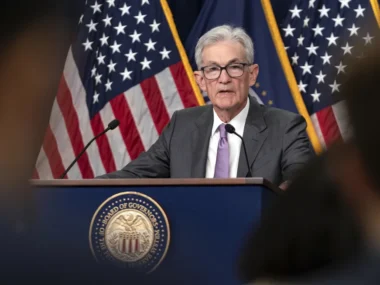Americans and Federal Reserve officials have reason to celebrate: Inflation dropped significantly last month, likely boosting central bankers’ confidence in continuing interest rate cuts.
The Fed’s preferred inflation measure, the Personal Consumption Expenditures price index, showed a 2.2% increase in consumer prices over the year ending in August, down from 2.5% in July. This brings inflation closer to the Fed’s 2% target and is the lowest rate since February 2021, when inflation was at 1.9%.
The annual rise was below the 2.3% economists had forecast, based on FactSet estimates. On a monthly basis, prices increased by 0.1% in August, compared to a 0.2% rise in July, aligning with expectations.
However, “core” inflation, which excludes volatile food and energy prices, increased to an annual rate of 2.7% in August, up from 2.6% in July, matching economists’ predictions. Month-to-month, core inflation edged up 0.1% in August, compared to 0.2% in July, in line with forecasts.
President Joe Biden hailed the report as a positive step for the economy, noting inflation is returning to pre-pandemic levels. “We still have work to do to lower costs and create opportunities for Americans,” Biden said in a Friday statement.
Additional Cuts are Anticipated?
The recent progress, with inflation nearing 2% and a cooling labor market, prompted central bankers to implement a significant half-point rate cut earlier this month, rather than the usual quarter-point adjustment. The inflation report released on Friday suggests that another substantial cut, which would ease borrowing costs for Americans, could be forthcoming. However, Fed Governor Michelle Bowman, the sole member of the 12-person committee to support a smaller cut at the last meeting, voiced concerns that a larger reduction might “unnecessarily” boost demand and drive prices higher. “We have not yet reached our inflation target,” she stated last week.
While Bowman may see Friday’s report as a positive development, it might not be sufficient to sway her to support another half-point cut at the Fed’s November meeting. Conversely, other officials may interpret the data as an indication that they can proceed with aggressive rate cuts without significant inflation concerns.
Additionally, Fed Governor Christopher Waller mentioned in a CNBC interview last week that the Producer Price Index (PPI) data from August, which reflects wholesale prices, influenced his decision to endorse the larger cut. The PPI report indicated a notable slowdown in wholesale prices, with an annual increase of 1.7% in August, down from 2.1% the previous month. This wholesale pricing data is generally viewed as a leading indicator of future consumer prices for goods and services.
A Cautionary Indicator from Consumer Spending, Accompanied by a Touch of Reassurance.
Friday’s report arrives as the resilient American consumer—largely unfazed by the highest interest rates in over two decades—is becoming increasingly selective in their spending habits.
In inflation-adjusted terms, spending rose by 0.1% last month, with expenditures on goods remaining nearly flat compared to July, while spending on services increased by 0.2%.
However, wage growth for workers is beginning to stagnate, as the labor market shows signs of weakening, with companies reducing hiring and the unemployment rate rising significantly over the past year.
“This puts consumers in a cautious position,” noted Kathy Bostjancic, chief economist at Nationwide. Nevertheless, the report also revealed that consumers have more savings than previously estimated. Recent data from the Commerce Department suggested that consumers were saving around 3% of their disposable income, but revised figures indicate a savings rate closer to 5% for those months, including August. Despite this, consumers are still saving less than they did prior to the pandemic, when the personal saving rate was around 7%.
According to Wells Fargo economists, “The consumer appears to be on more solid ground,” suggesting that households may have a bit more capacity to support consumption.
However, this may not significantly alter the Fed’s approach to rate cuts. Ultimately, upcoming job report data will likely play a crucial role in determining whether the Fed will cut rates at their November policy meeting and by how much, Bostjancic told CNN.
One concern for Fed officials is that larger rate cuts could encourage spending that consumers are currently delaying, which is helping to keep inflation in check. However, Bostjancic believes that even if the central bank were to implement another half-point cut in November, rates would still be high enough to prevent consumers from engaging in excessive spending.
Conversely, lower- and middle-income consumers are facing financial challenges and “need some interest rate relief,” she added.











